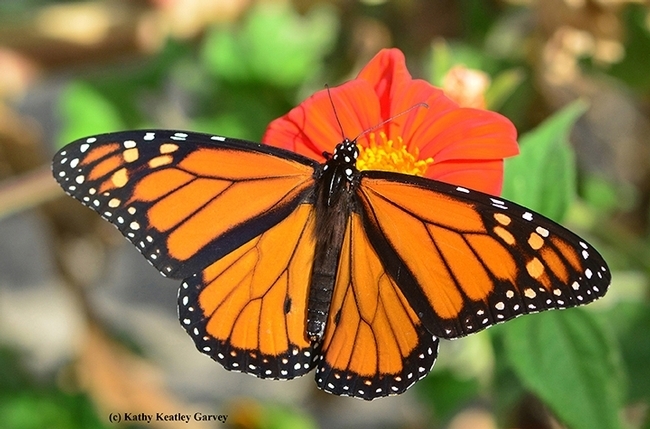- Author: Kathy Keatley Garvey
The Gulf Fritillary, Agraulis vanillae, is definitely back from a comeback, at least in the Sacramento, Davis and Vacaville-Fairfield areas.
In September of 2009, butterfly guru Art Shapiro, now a UC Davis distinguished professor emeritus, excitedly announced the re-appearance of the Gulf Fritillary butterfly in the Sacramento metropolitan area after a four-decade absence, and in the Davis area after a 30-year absence.
The showy butterfly colonized both south Sacramento and the Winding Way/Auburn Boulevard area in the 1960s but by 1971 "apparently became extinct or nearly so," recalled Shapiro, who has monitored the butterfly populations of central California since 1972 and maintains a research website at https://butterfly.ucdavis.edu.
It's a tropical and subtropical butterfly with a range that extends from the southern United States all the way to central Argentina.
No one knows exactly when the first Gulf Frit first arrived in California, but "it was already in the San Diego area by about 1875, Shapiro says, and it was first recorded in the San Francisco Bay Area around 1908.
A recent piece in The Acorn, published by the Effie Yeaw Nature Center, Carmichael, and authored by UC Davis entomologist Mary Louise Flint (see article), indicated the Gulf Fritillary is doing well in the area.
Good news!
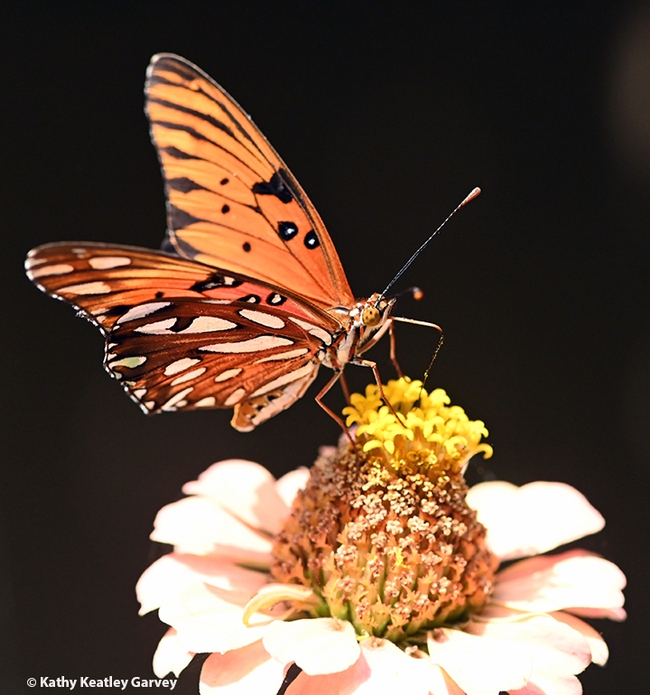
- Author: Kathy Keatley Garvey
A gray butterfly and a fruit fly...
Each has "fly" in its name but one is a member of the order Lepidoptera and the other, order Diptera. Etymology does not agree with entomology.
Ever managed to photograph a butterfly and fruit fly in the same image?
Presenting: a gray hairstreak butterfly, Strymon melinus, and a fruit fly, Neotephritis finalis, an organism commonly known as "the sunflower seed maggot."
They were foraging March 21 in a Vacaville garden on Coreopsis, a genus of flowering plants in Asteraceae.
N. finalis, one of the most commonly seen fruit flies (tephritids) flies in North America. develops in the seed heads of plants in the sunflower family. They're also called "picture-winged flies." BugGuide.net tells us "Wings are mostly dark in apical half with six hyaline spots forming a distinct triangle."
The wings are indeed striking!
But so are the wings of the gray hairstreak butterfly. That orange spot with a black dot on the hindwing probably resembles an eye to a predator.
Butterfly guru Art Shapiro, UC Davis distinguished professor emeritus, says on his research website that the gray hairstreak "is one of the most polyphagous butterflies known, recorded on host plants in many families. Its most frequent hosts in our area are mallows, including the weedy species of Malva; legumes, including Spanish Lotus (Lotus purshianus), Bird's-Foot Trefoil (Lotus corniculatus), White Clover (Trifolium repens) in lawns, Alfalfa (Medicago sativa) and many others; and Turkey Mullein (Eremocarpus or Croton setigerus, Euphorbiaceae)."
Maybe we'll see the butterfly and the fruit fly again...
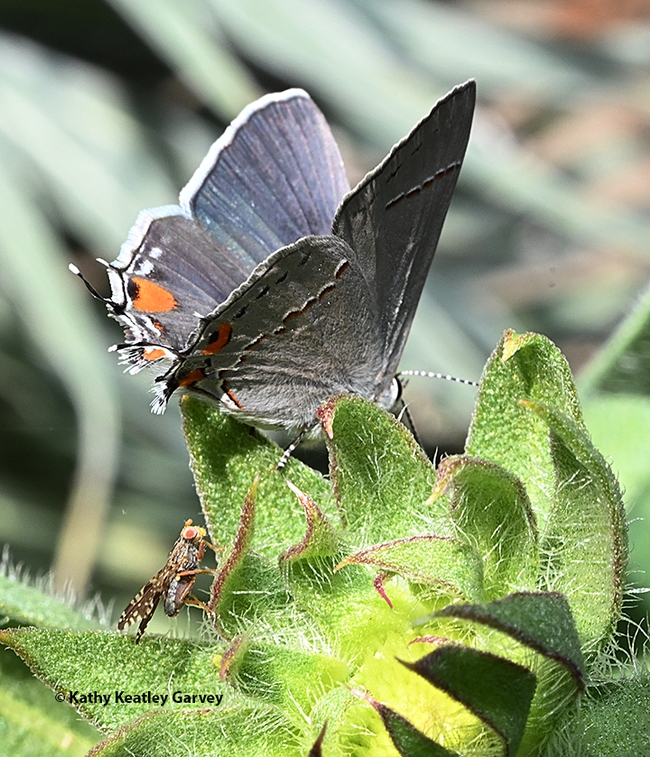
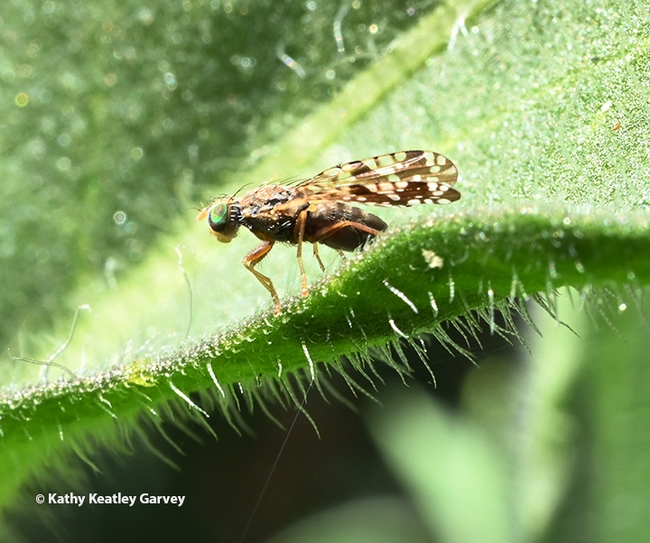
- Author: Kathy Keatley Garvey
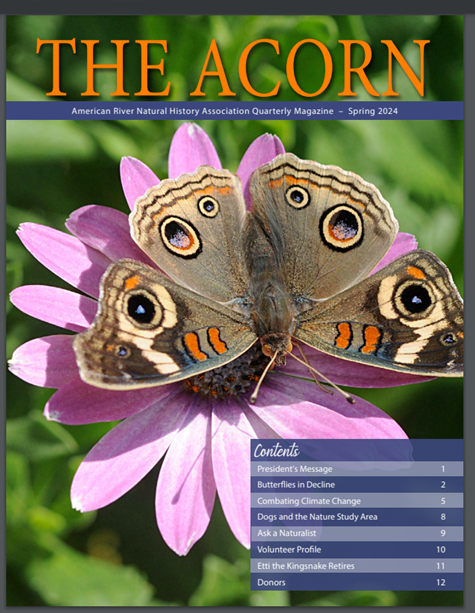
You'll learn which butterfly populations are struggling and which ones are doing well, and glean more information about the research of UC Davis distinguished professor emeritus Art Shapiro, and his collaborator, Professor Matt Forister of the University of Nevada, his former doctoral student.
Shapiro has been monitoring the butterfly populations of central California since 1972. His transect of ten fixed study sites sprawls from the Sacramento River Delta, through the Sacramento Valley and Sierra Nevada mountains, and to the high desert of the western Great Basin. The sites, Shapiro says, "represent the great biological, geological, and climatological diversity of central California."
The article is authored by entomologist Mary Louise Flint, a docent at the center and editor of the quarterly. She holds the title of professor of Cooperative Extension emerita, based in the UC Davis Department of Entomology and Nematology. She served as a longtime associate director of the UC Statewide Integrated Pest Management Program (UC IPM) until her retirement in June 2014. (See her biography on the UC IPM website).
"Over the last decade or two, scientists in many parts of the world have documented examples of declining insect num- bers—both in numbers of species (species richness) and in the number of individuals of each species (population levels)," Flint began. "Habitat loss, pesticide use, and climate change are usually identified as the main contributing factors, although circumstances vary among insect species and location."
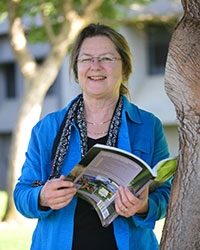
"Three of Shapiro's sample sites," Flint pointed out, "are relatively close to our nature area—Rancho Cordova, near the American River across from Sacramento Bar, North Sacramento on the American River near California State University, and West Sacramento in the Yolo Bypass near the causeway. (The Rancho Cordova site is closest and most similar to Effie Yeaw in habitat.) A close study of the data collected at these sites between 1988 and 2010 showed that summer minimum temperatures and fall maximum temperatures increased significantly and precipitation decreased. During this time, species richness tended to decrease after years of high temperatures and reduced precipitation."

Among those on "the struggling list" are the monarch, Danaus plexippus; West Coast lady, Vanessa annabella; the great copper, Lycaena xanthoides; and the large marble, Euchloe ausonides. The large marble, "formerly common in the Central Valley, Delta, Bay Area and lower foothills...has suffered an unexplained crash and is teetering on the brink of regional extinction," according to Shapiro's website.
Those on the "doing well" list include the Gulf Fritillary, Agraulis vanillae; pipevine swallowtail, Battus philenor; fiery skipper, Hylephila phyleus; the Western tiger swallowtail, Papilio rutulus; and the gray hairstreak, Strymon melinus.
See Flint's article for more information, and access Shapiro's research research website, and Forister's research website.
A buckeye butterfly, Junonia coenia (image by yours truly) graces the cover. Numerous other butterfly images illustrate the piece.
Shapiro recently delivered a presentation, "Using Butterflies to Understand Biotic Responses to Climate Change," at the UC Davis emeriti celebration, organized and coordinated by UC Davis Distinguished Professor Walter Leal of the Department of Molecular and Cellular Biology. (See Shapiro's presentation on YouTube and coverage on Bug Squad blog.)
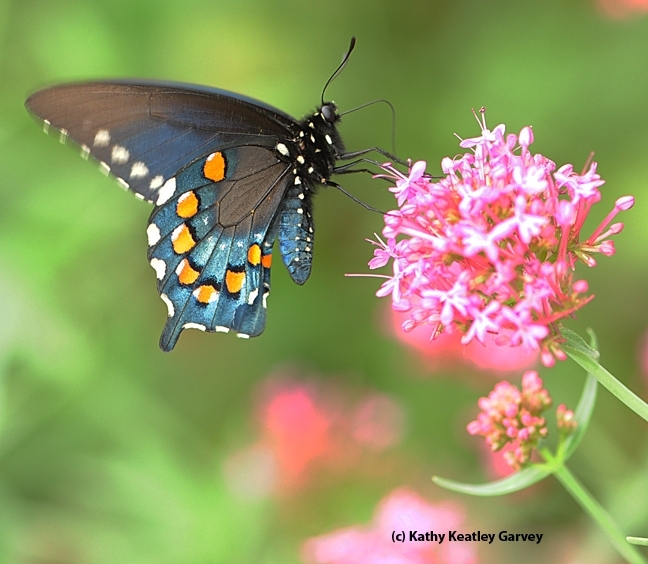
- Author: Kathy Keatley Garvey
One of the first butterflies we see in the UC Davis Arboretum and Public Garden in midwinter is the Red Admiral, Vanessa atalanta.
Yes, this butterfly overwinters as an adult. It's picture-perfect with black wings, red bands and white spots. And on a picture-perfect day in midwinter, you may see it.
Or as butterfly guru Art Shapiro, UC Davis distinguished professor emeritus, says on his Art's Butterfly World website: "One of the most frequently seen butterflies in midwinter at low elevation, and often very common in the urban Bay Area, the Red Admiral occurs all around the Northern Hemisphere. It is multiple-brooded, overwinters as an adult, and may undergo altitudinal migration in the Sierra (where it is generally uncommon)."
"The larval hosts are all members of the Nettle family, Urticaceae, including not only the familiar Stinging Nettles (Urtica holosericea and U. urens) but the tiny-leaved ground cover Baby's Tears (Helxine or Soleirolia) in moist, shaded gardens and the climbing urban weed Pellitory (Parietaria) in the Bay Area. The larva is solitary, in a rolled-leaf shelter."
Shapiro has been monitoring butterfly populations in Central California since 1972. And the Red Admiral is just one of them.
If you visit the UC Davis Arboretum a picture-perfect day, you must may get the opportunity to admire the Red Admiral...This one was on a Roldana aschenborniana (Golden Light Senecio).
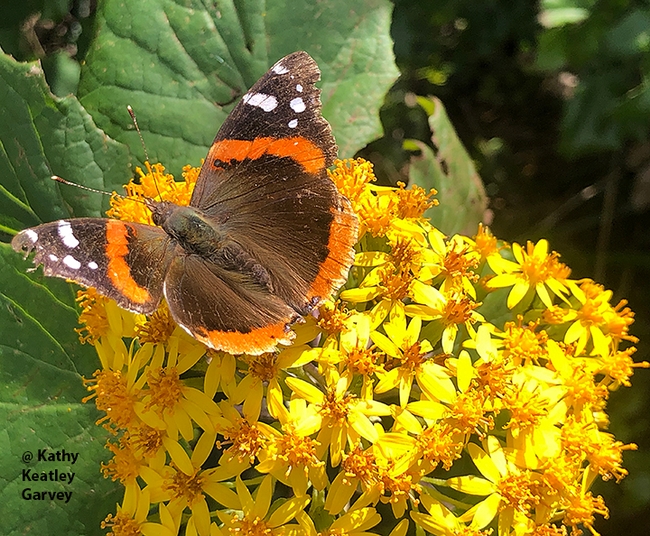
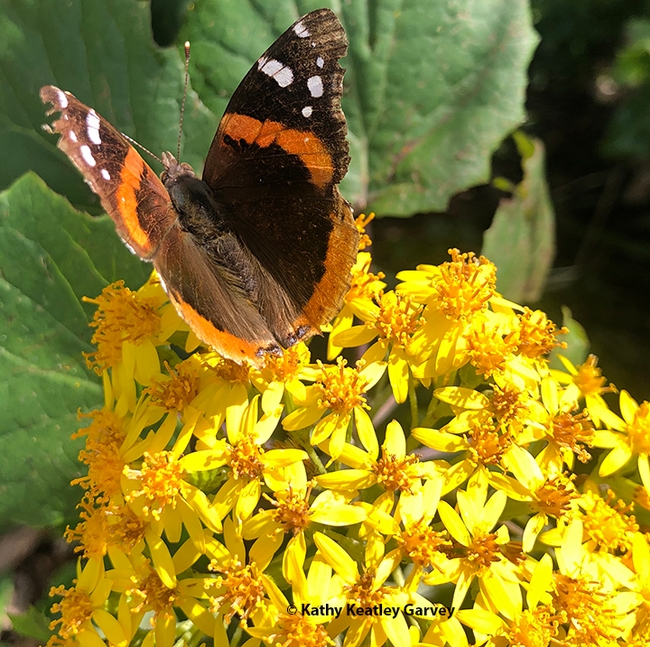
- Author: Kathy Keatley Garvey
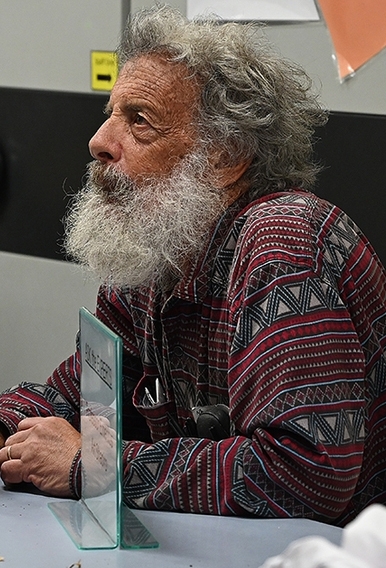
When UC Davis distinguished professor Walter Leal of the Department of Molecular and Cellular Biology organized and hosted an emeriti celebration honoring professors who recently transitioned to emeriti, he didn't stop when the presentations ended.
Leal invited his biochemistry students that he's teaching this quarter to summarize, in a short video, one of the emerti lectures. "I let them decide which one," he said. "They submitted 45 videos and covered all the speakers." The event, held in the International Center, celebrated 73 faculty who retired in the 2022-2023 cohort. Chancellor Gary May welcomed the crowd, and paid tribute to the new retirees and their accomplishments.
Butterfly guru Art Shapiro, UC Davis distinguished professor emeritus, who has monitored butterfly populations in Central California since 1972, spoke on "Using Butterflies to Understand Biotic Responses to Climate Change." He recently retired from the UC Davis Department of Evolution and Ecology faculty, but continues his research with his former doctoral student, Professor Matt Forister of the University of Nevada. Shapiro maintains a research website at https://butterfly.ucdavis.edu. (Read his emeriti presentation on the March 11th Bug Squad blog)
So which student chose to comment on Shapiro's presentation? A butterfly enthusiast: Elly Fry-Ross, a third-year biochemistry and molecular biology major with a minor in psychology.
And butterflies? "I've always loved butterflies ever since I was little," Elly said, adding that the colors fascinate her. "My parents used to take me to the rainforest exhibit at the California Academy of Sciences to see the butterflies and hopefully have one land on me!"
And every year on campus, Elly attends the butterfly and moth exhibit at the Bohart Museum of Entomology during the annual UC Davis Biodiversity Museum Day and during the campuswide Picnic Day, which this year is Saturday, April 20. (This year the Bohart Museum will be closed on Picnic Day, but will move its activities to a pop-up tent at Briggs Hall.)
Elly's career plans? To enroll in a medical school and become a physician.
See the student videos at https://www.youtube.com/watch?v=p1LZbErkx28
Emeriti Celebration Links
00:00 Getting ready to start 00:15 Opening remarks, Walter Leal 03:26 Land Acknowledgment 06:35 Chancellor Gary May 8:50 Cal Qualset 11:40 Paul Gepts presentation 42:37 Robert Szabo's impromptu remarks 45:40 Bruce Hammock 47:45 Isaac Pessah 1:15:40 Congratulations on your retirement, Jay Lund! 1:18:12 William (Bill) Lacy 1:22:05 Ines Hernandez-Avila 1:52:59 Ken Burtis 1:57:10 Art Shapiro 2:20:50 Q&A 2:28:50 Art Shapiro's additional remarks 2:29:44 Emeriti Napkin 2:29:57 UCDEA Video Recording Interview
Afternoon Session
https://youtu.be/AMs2Q1bimxA
00:00 Highlights of the luncheon 01:20 Suad Joseph, UCDEA 13:16 Mont Hubbard 16:40 Simon Cherry 51:44 Jeffery Gibeling 56:52 Subhash Risbud 1:23:25 Snapshot with undergraduate students 1:23:48 Clark Lagarias 1:26:19 Anne Britt 2:00:30 Sascha Nicklisch 2:03:53 Ron Tjeerdema 2:36:30 Edward Callahan 2:40:45 Andres Sciolla 3:09:41 Mary Croughan 3:18:10 Walter Leal 3:18:55 After the event
